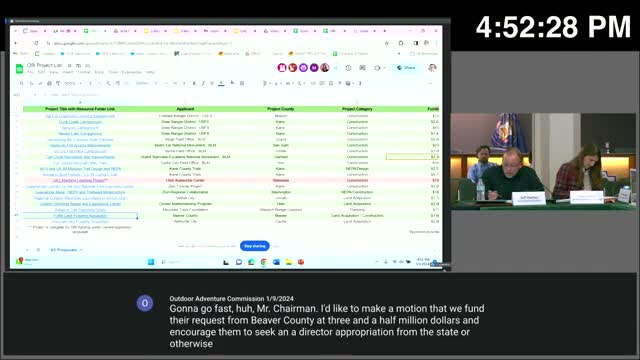Beaver County seeks $3.5M for Puffer Lake project amid funding discussions
March 31, 2024 | Utah Outdoor Adventure Commission, Utah Department of Natural Resources, Utah Government Divisions, Utah Legislative Branch, Utah

This article was created by AI summarizing key points discussed. AI makes mistakes, so for full details and context, please refer to the video of the full meeting. Please report any errors so we can fix them. Report an error »

In a recent meeting of the Utah Outdoor Adventure Commission, significant discussions centered around funding proposals aimed at enhancing outdoor recreation in the state, particularly focusing on Beaver County and the Zion National Park area. The commission's deliberations highlighted the challenges faced by smaller communities in securing financial resources for outdoor projects, as well as the potential benefits of proposed initiatives.
One of the key topics was a funding request of $3.5 million for Beaver County, which is struggling with limited tourism and economic resources. Commission members expressed sympathy for the county's situation, noting that while the funding request is substantial, it could greatly benefit the local community and the broader Paiute Trail system. The discussion emphasized the importance of state support, with suggestions that Beaver County could seek additional funding through direct appropriations or state park management agreements to help realize the project.
The commission also explored the implications of a proposed Avalanche Center project, which aims to improve access to outdoor recreation sites. However, concerns were raised regarding the current limitations of the Outdoor Recreation Initiative's funding criteria. The existing code restricts funding to specific types of infrastructure, such as trails and campgrounds, which may not encompass the broader needs of projects like the Avalanche Center. A potential code change was discussed to allow for a wider range of funding uses, including planning expenses, which could facilitate more comprehensive outdoor projects in the future.
Another significant proposal involved the experiential corridor for the Zion National Park Discovery Center, aimed at addressing overcrowding in the park. While some commission members supported the initiative, others questioned its alignment with traditional outdoor recreation funding, suggesting it primarily enhances the visitor center rather than developing new recreational trails. The debate highlighted the need for clarity on funding priorities and the types of projects that should be supported under the current framework.
As the meeting concluded, the commission recognized the importance of these discussions in shaping Utah's outdoor recreation landscape. The outcomes of these funding proposals and potential code changes will be closely monitored, as they hold the promise of enhancing outdoor experiences for both residents and visitors in the state. The commission's next steps will likely involve further exploration of funding sources and legislative adjustments to better support outdoor initiatives across Utah.
One of the key topics was a funding request of $3.5 million for Beaver County, which is struggling with limited tourism and economic resources. Commission members expressed sympathy for the county's situation, noting that while the funding request is substantial, it could greatly benefit the local community and the broader Paiute Trail system. The discussion emphasized the importance of state support, with suggestions that Beaver County could seek additional funding through direct appropriations or state park management agreements to help realize the project.
The commission also explored the implications of a proposed Avalanche Center project, which aims to improve access to outdoor recreation sites. However, concerns were raised regarding the current limitations of the Outdoor Recreation Initiative's funding criteria. The existing code restricts funding to specific types of infrastructure, such as trails and campgrounds, which may not encompass the broader needs of projects like the Avalanche Center. A potential code change was discussed to allow for a wider range of funding uses, including planning expenses, which could facilitate more comprehensive outdoor projects in the future.
Another significant proposal involved the experiential corridor for the Zion National Park Discovery Center, aimed at addressing overcrowding in the park. While some commission members supported the initiative, others questioned its alignment with traditional outdoor recreation funding, suggesting it primarily enhances the visitor center rather than developing new recreational trails. The debate highlighted the need for clarity on funding priorities and the types of projects that should be supported under the current framework.
As the meeting concluded, the commission recognized the importance of these discussions in shaping Utah's outdoor recreation landscape. The outcomes of these funding proposals and potential code changes will be closely monitored, as they hold the promise of enhancing outdoor experiences for both residents and visitors in the state. The commission's next steps will likely involve further exploration of funding sources and legislative adjustments to better support outdoor initiatives across Utah.
View full meeting
This article is based on a recent meeting—watch the full video and explore the complete transcript for deeper insights into the discussion.
View full meeting

